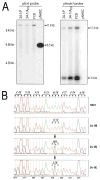Mutations in the P. falciparum digestive vacuole transmembrane protein PfCRT and evidence for their role in chloroquine resistance
- PMID: 11090624
- PMCID: PMC2944663
- DOI: 10.1016/s1097-2765(05)00077-8
Mutations in the P. falciparum digestive vacuole transmembrane protein PfCRT and evidence for their role in chloroquine resistance
Abstract
The determinant of verapamil-reversible chloroquine resistance (CQR) in a Plasmodium falciparum genetic cross maps to a 36 kb segment of chromosome 7. This segment harbors a 13-exon gene, pfcrt, having point mutations that associate completely with CQR in parasite lines from Asia, Africa, and South America. These data, transfection results, and selection of a CQR line harboring a novel K761 mutation point to a central role for the PfCRT protein in CQR. This transmembrane protein localizes to the parasite digestive vacuole (DV), the site of CQ action, where increased compartment acidification associates with PfCRT point mutations. Mutations in PfCRT may result in altered chloroquine flux or reduced drug binding to hematin through an effect on DV pH.
Figures



Similar articles
-
Drug resistance-associated pfCRT mutations confer decreased Plasmodium falciparum digestive vacuolar pH.Mol Biochem Parasitol. 2004 Jan;133(1):99-114. doi: 10.1016/j.molbiopara.2003.09.008. Mol Biochem Parasitol. 2004. PMID: 14668017
-
A critical role for PfCRT K76T in Plasmodium falciparum verapamil-reversible chloroquine resistance.EMBO J. 2005 Jul 6;24(13):2294-305. doi: 10.1038/sj.emboj.7600681. Epub 2005 Jun 9. EMBO J. 2005. PMID: 15944738 Free PMC article.
-
Functional characterization of the Plasmodium falciparum chloroquine-resistance transporter (PfCRT) in transformed Dictyostelium discoideum vesicles.PLoS One. 2012;7(6):e39569. doi: 10.1371/journal.pone.0039569. Epub 2012 Jun 19. PLoS One. 2012. PMID: 22724026 Free PMC article.
-
Defining the role of PfCRT in Plasmodium falciparum chloroquine resistance.Mol Microbiol. 2005 Apr;56(2):323-33. doi: 10.1111/j.1365-2958.2005.04556.x. Mol Microbiol. 2005. PMID: 15813727 Review.
-
pfcrt is more than the Plasmodium falciparum chloroquine resistance gene: a functional and evolutionary perspective.Acta Trop. 2005 Jun;94(3):170-80. doi: 10.1016/j.actatropica.2005.04.004. Acta Trop. 2005. PMID: 15866507 Review.
Cited by
-
A novel 4-aminoquinoline chemotype with multistage antimalarial activity and lack of cross-resistance with PfCRT and PfMDR1 mutants.PLoS Pathog. 2024 Oct 29;20(10):e1012627. doi: 10.1371/journal.ppat.1012627. eCollection 2024 Oct. PLoS Pathog. 2024. PMID: 39471233 Free PMC article.
-
Optimization of loop mediated isothermal amplification assay (LAMP) for detection of chloroquine resistance in P. vivax malaria.Sci Rep. 2024 Oct 27;14(1):25608. doi: 10.1038/s41598-024-76479-7. Sci Rep. 2024. PMID: 39465271 Free PMC article.
-
Design, synthesis and mechanistic insights into triclosan derived dimers as potential anti-plasmodials.RSC Med Chem. 2024 Oct 11. doi: 10.1039/d4md00494a. Online ahead of print. RSC Med Chem. 2024. PMID: 39464649 Free PMC article.
-
Identification of the drug/metabolite transporter 1 as a marker of quinine resistance in a NF54×Cam3.II P. falciparum genetic cross.bioRxiv [Preprint]. 2024 Oct 1:2024.09.27.615529. doi: 10.1101/2024.09.27.615529. bioRxiv. 2024. PMID: 39386571 Free PMC article. Preprint.
-
Bovine lactoferrin inhibits Plasmodium berghei growth by binding to heme.Sci Rep. 2024 Sep 2;14(1):20344. doi: 10.1038/s41598-024-70840-6. Sci Rep. 2024. PMID: 39223194 Free PMC article.
References
-
- Bitonti AJ, Sjoerdsma A, McCann PP, Kyle DE, Oduola AM, Rossan RN, Milhous WK, Davidson D., Jr Reversal of chloroquine resistance in malaria parasite Plasmodium falciparum by desipramine. Science. 1988;242:1301–1303. - PubMed
-
- Bray PG, Mungthin M, Ridley RG, Ward SA. Access to hematin: the basis of chloroquine resistance. Mol Pharmacol. 1998;54:170–179. - PubMed
-
- Crabb BS, Triglia T, Waterkeyn JG, Cowman AF. Stable transgene expression in Plasmodium falciparum. Mol Biochem Parasitol. 1997;90:131–144. - PubMed
-
- De D, Krogstad FM, Cogswell FB, Krogstad DJ. Aminoquinolines that circumvent resistance in Plasmodium falciparum in vitro. Am J Trop Med Hyg. 1996;55:579–583. - PubMed
Publication types
MeSH terms
Substances
Associated data
- Actions
- Actions
- Actions
- Actions
- Actions
- Actions
Grants and funding
LinkOut - more resources
Full Text Sources
Molecular Biology Databases

